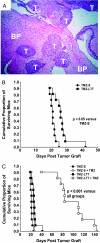Long-term temozolomide treatment induces marked amino metabolism modifications and an increase in TMZ sensitivity in Hs683 oligodendroglioma cells
- PMID: 20072655
- PMCID: PMC2805885
- DOI: 10.1593/neo.91360
Long-term temozolomide treatment induces marked amino metabolism modifications and an increase in TMZ sensitivity in Hs683 oligodendroglioma cells
Abstract
Gliomas account for more than 50% of all primary brain tumors. The worst prognosis is associated with gliomas of astrocytic origin, whereas gliomas with an oligodendroglial origin offer higher sensitivity to chemotherapy, especially when oligodendroglioma cells display 1p19q deletions. Temozolomide (TMZ) provides therapeutic benefits and is commonly used with radiotherapy in highly malignant astrocytic tumors, including glioblastomas. The actual benefits of TMZ during long-term treatment in oligodendroglioma patients have not yet been clearly defined. In this study, we have investigated the effects of such a long-term TMZ treatment in the unique Hs683 oligodendroglioma model. We have observed increased TMZ sensitivity of Hs683 orthotopic tumors that were previously treated in vitro with months of progressive exposure to increasing TMZ concentrations before being xenografted into the brains of immunocompromised mice. Whole-genome and proteomic analyses have revealed that this increased TMZ sensitivity of Hs683 oligodendroglioma cells previously treated for long periods with TMZ can be explained, at least partly, by a TMZ-induced p38-dependant dormancy state, which in turn resulted in changes in amino acid metabolism balance, in growth delay, and in a decrease in Hs683 oligodendroglioma cell-invasive properties. Thus, long-term TMZ treatment seems beneficial in this Hs683 oligodendroglioma model, which revealed itself unable to develop resistance against TMZ.
Figures





Similar articles
-
Long-term in vitro treatment of human glioblastoma cells with temozolomide increases resistance in vivo through up-regulation of GLUT transporter and aldo-keto reductase enzyme AKR1C expression.Neoplasia. 2010 Sep;12(9):727-39. doi: 10.1593/neo.10526. Neoplasia. 2010. PMID: 20824049 Free PMC article.
-
Inhibiting stemness and invasive properties of glioblastoma tumorsphere by combined treatment with temozolomide and a newly designed biguanide (HL156A).Oncotarget. 2016 Oct 4;7(40):65643-65659. doi: 10.18632/oncotarget.11595. Oncotarget. 2016. PMID: 27582539 Free PMC article.
-
Inhibition of DNA-repair genes Ercc1 and Mgmt enhances temozolomide efficacy in gliomas treatment: a pre-clinical study.Oncotarget. 2015 Oct 6;6(30):29456-68. doi: 10.18632/oncotarget.4909. Oncotarget. 2015. PMID: 26336131 Free PMC article.
-
Response of low-grade oligodendroglial tumors to temozolomide.J Neurooncol. 2004 Dec;70(3):279-80. doi: 10.1007/s11060-004-5896-4. J Neurooncol. 2004. PMID: 15662968 Review. No abstract available.
-
Complete durable response of a pediatric anaplastic oligodendroglioma to temozolomide alone: Case report and review of literature.Pediatr Blood Cancer. 2017 Dec;64(12):10.1002/pbc.26708. doi: 10.1002/pbc.26708. Epub 2017 Jul 11. Pediatr Blood Cancer. 2017. PMID: 28696020 Free PMC article. Review.
Cited by
-
The interconnectedness of cancer cell signaling.Neoplasia. 2011 Dec;13(12):1183-93. doi: 10.1593/neo.111746. Neoplasia. 2011. PMID: 22241964 Free PMC article.
-
Autophagy in brain tumors: molecular mechanisms, challenges, and therapeutic opportunities.J Transl Med. 2025 Jan 13;23(1):52. doi: 10.1186/s12967-024-06063-0. J Transl Med. 2025. PMID: 39806481 Free PMC article. Review.
-
Triacetin-based acetate supplementation as a chemotherapeutic adjuvant therapy in glioma.Int J Cancer. 2014 Mar 15;134(6):1300-10. doi: 10.1002/ijc.28465. Epub 2013 Sep 30. Int J Cancer. 2014. PMID: 23996800 Free PMC article.
-
Deciphering the Role of Autophagy in Treatment of Resistance Mechanisms in Glioblastoma.Int J Mol Sci. 2021 Jan 28;22(3):1318. doi: 10.3390/ijms22031318. Int J Mol Sci. 2021. PMID: 33525678 Free PMC article. Review.
-
Oligodendroglioma Cells Lack Glutamine Synthetase and Are Auxotrophic for Glutamine, but Do not Depend on Glutamine Anaplerosis for Growth.Int J Mol Sci. 2018 Apr 6;19(4):1099. doi: 10.3390/ijms19041099. Int J Mol Sci. 2018. PMID: 29642388 Free PMC article.
References
-
- Louis DN. Molecular pathology of malignant gliomas. Annu Rev Pathol. 2006;1:97–117. - PubMed
-
- Louis DN, Ohgaki H, Wiestler OD, Cavenee WK. WHO Classification of Tumours of the Central Nervous System. Lyon, France: International Agency for Research on Cancer (IARC); 2007.
-
- Stupp R, Mason WP, van den Bent MJ, Weller M, Fisher B, Taphoorn MJ, Belanger K, Brandes AA, Marosi C, Bogdahn U, et al. Radiotherapy plus concomitant and adjuvant temozolomide for glioblastoma. N Engl J Med. 2005;352:987–996. - PubMed
-
- Stupp R, Hegi ME, Gilbert MR, Chakravarti A. Chemoradiotherapy in malignant glioma: standard of care and future directions. J Clin Oncol. 2007;25:4127–4136. - PubMed
Publication types
MeSH terms
Substances
LinkOut - more resources
Full Text Sources
Medical
